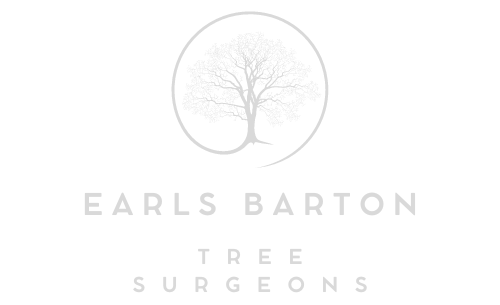Why Weak Branch Unions Pose a Serious Hazard
Healthy, well-structured trees add beauty, shade, and value to any property. However, when a tree develops weak branch unions, it can become a serious safety risk. Many homeowners overlook these subtle warning signs until it’s too late, resulting in fallen branches or structural failure during bad weather. At Earls Barton Tree Surgeons, we help property owners across Earls Barton and Northamptonshire understand the importance of identifying and managing weak branch unions before they lead to costly or dangerous situations.
What Is a Weak Branch Union?
A weak branch union occurs when two or more branches grow too closely together, often forming a narrow “V” shape instead of a strong “U.” In this position, bark becomes trapped between the stems — a condition known as included bark. Instead of bonding together, the bark creates a wedge that weakens the connection between the branches.
Over time, this structural flaw prevents the wood from fusing properly. As the branches continue to grow and increase in weight, internal pressure builds up along the joint. This makes it far more likely for the branch to split or snap, particularly during storms or under the strain of heavy foliage.
Why Weak Branch Unions Are Dangerous
Weak branch unions may seem harmless at first glance, but they can quickly become a liability under the right conditions. Here are some reasons they pose a serious hazard:
1. Increased Risk of Sudden Breakage
Branches with included bark are structurally compromised. Even a moderate wind gust or added weight from rain or snow can cause them to fail unexpectedly. Such sudden breakages can damage property, vehicles, or even injure people below.
2. Progressive Decay and Disease
When cracks form at a weak union, they create openings that allow moisture, fungi, and bacteria to enter the tree. This can lead to internal rot, weakening the structure even further. Without early intervention, the decay may spread to the main trunk, affecting the overall health of the tree.
3. Imbalance and Structural Instability
As the tree continues to grow, one of the connected branches may dominate the other, creating uneven weight distribution. This imbalance puts additional stress on the tree, increasing the likelihood of partial or total failure.
4. Safety Hazards in Public or Residential Areas
In residential areas like Earls Barton, trees often stand near roads, gardens, and homes. A single falling branch can cause significant disruption and danger. Preventative action from professionals such as Earls Barton Tree Surgeons ensures that potential hazards are addressed before they escalate.
How to Identify a Weak Branch Union
Recognising weak branch unions early is key to maintaining a safe and healthy tree. Here are a few signs to look for:
- Narrow “V”-shaped crotches between branches instead of broad “U”-shaped ones.
- Visible cracks or splits where two branches meet.
- Bark growing inward between branches, forming a seam.
- Uneven growth patterns where one branch appears to be pushing against another.
If you notice any of these symptoms, it’s best to have your tree assessed by a professional arborist. At Earls Barton Tree Surgeons, we use our expertise to identify these issues during routine inspections and recommend appropriate pruning or support methods.
Professional Solutions for Weak Branch Unions
Managing weak branch unions requires precision and an understanding of tree biology. Here are some common solutions used by professionals:
1. Corrective Pruning
Removing one of the competing stems early in a tree’s life can eliminate the problem entirely. For mature trees, selective pruning reduces the strain on weak unions and helps redirect growth into stronger, healthier areas.
2. Cabling and Bracing
In some cases, trees with valuable or sentimental importance can be reinforced using specialist support systems. Cabling and bracing provide mechanical strength, reducing the chance of failure while preserving the tree’s shape and stability.
3. Ongoing Maintenance
Routine inspections and maintenance ensure that weak unions don’t worsen over time. Professionals like Earls Barton Tree Surgeons offer scheduled care programmes to monitor growth patterns, prune appropriately, and maintain tree balance.
Preventing Weak Branch Unions in Young Trees
The best time to prevent weak unions is during a tree’s early growth stages. Proper formative pruning encourages a single dominant leader and evenly spaced branches. Regular monitoring as the tree matures ensures that any developing weaknesses are corrected before they pose a risk.
When planting new trees, choosing the right species and spacing also helps reduce the likelihood of structural weaknesses. Trees that naturally form strong branch angles, such as oak or beech, are generally less prone to included bark than fast-growing species like willow or silver birch.
Conclusion
Weak branch unions are more than just an aesthetic flaw — they represent a hidden danger that can lead to major damage or even injury. Early detection, professional pruning, and ongoing maintenance are key to ensuring trees remain strong and safe for years to come.
At Earls Barton Tree Surgeons, we provide expert assessment and care for trees throughout Earls Barton and Northamptonshire. Our experienced team understands how to identify and manage structural weaknesses before they become hazards, helping property owners maintain both safety and the natural beauty of their landscapes. With the right care, your trees can stand tall, secure, and healthy through every season.
Call us on: 01604 279 697
Click here to find out more about Earls Barton Tree Surgeons
Click here to complete our contact form and see how we can help with your tree needs.

